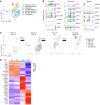Single-cell transcriptomic analysis of renal allograft rejection reveals insights into intragraft TCR clonality
- PMID: 37227784
- PMCID: PMC10348771
- DOI: 10.1172/JCI170191
Single-cell transcriptomic analysis of renal allograft rejection reveals insights into intragraft TCR clonality
Abstract
Bulk analysis of renal allograft biopsies (rBx) identified RNA transcripts associated with acute cellular rejection (ACR); however, these lacked cellular context critical to mechanistic understanding of how rejection occurs despite immunosuppression (IS). We performed combined single-cell RNA transcriptomic and TCR-α/β sequencing on rBx from patients with ACR under differing IS drugs: tacrolimus, iscalimab, and belatacept. We found distinct CD8+ T cell phenotypes (e.g., effector, memory, exhausted) depending upon IS type, particularly within expanded CD8+ T cell clonotypes (CD8EXP). Gene expression of CD8EXP identified therapeutic targets that were influenced by IS type. TCR analysis revealed a highly restricted number of CD8EXP, independent of HLA mismatch or IS type. Subcloning of TCR-α/β cDNAs from CD8EXP into Jurkat 76 cells (TCR-/-) conferred alloreactivity by mixed lymphocyte reaction. Analysis of sequential rBx samples revealed persistence of CD8EXP that decreased, but were not eliminated, after successful antirejection therapy. In contrast, CD8EXP were maintained in treatment-refractory rejection. Finally, most rBx-derived CD8EXP were also observed in matching urine samples, providing precedent for using urine-derived CD8EXP as a surrogate for those found in the rejecting allograft. Overall, our data define the clonal CD8+ T cell response to ACR, paving the next steps for improving detection, assessment, and treatment of rejection.
Keywords: Immunology; Organ transplantation; T cell receptor; T cells; Transplantation.
Figures









Update of
-
Single cell transcriptomic analysis of renal allograft rejection reveals novel insights into intragraft TCR clonality.bioRxiv [Preprint]. 2023 Feb 13:2023.02.08.524808. doi: 10.1101/2023.02.08.524808. bioRxiv. 2023. Update in: J Clin Invest. 2023 Jul 17;133(14):e170191. doi: 10.1172/JCI170191. PMID: 36798151 Free PMC article. Updated. Preprint.
References
-
- Randhawa PS, et al. The histopathological changes associated with allograft rejection and drug toxicity in renal transplant recipients maintained on FK506. Clinical significance and comparison with cyclosporine. Am J Surg Pathol. 1993;17(1):60–68. doi: 10.1097/00000478-199301000-00007. - DOI - PMC - PubMed
Publication types
MeSH terms
Substances
Grants and funding
LinkOut - more resources
Full Text Sources
Other Literature Sources
Medical
Research Materials

